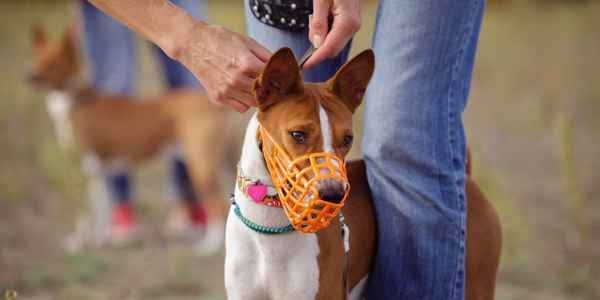 Every dog should be comfortable wearing a basket muzzle. Why? Dog muzzles are an incredibly useful tool for a variety of things. The most obvious one is that they help prevent bites toward humans or other animals.
Every dog should be comfortable wearing a basket muzzle. Why? Dog muzzles are an incredibly useful tool for a variety of things. The most obvious one is that they help prevent bites toward humans or other animals.
Any dog can bite. Dogs who are injured and in pain are more likely to bite — even biting an owner who may swear, "But they'd never bite me!"
Being able to put a muzzle on your dog in case of an accident or injury can help them stay calm and prevent injuries to yourself or the veterinary staff during treatment.
Start training your dog to wear a basket muzzle as early as possible! This way, if you ever need to use it, your dog will already be happy to wear it, and it's not an additional cause of stress or discomfort.
Table of Contents
Benefits of Muzzle Training Your Dog
Dog muzzles aren't just for dog bites! Muzzles can be helpful for dogs who obsessively grab and eat things off the ground while on walks or other adventures, often ending up with gastrointestinal obstructions. Does your dog eat poop? Certain muzzles have design options to prevent them from snacking on "turd treats."
Basket muzzles can be useful during post-surgery or injury recovery, as they can prevent the licking of stitches or wounds.
Dog breeds such as Greyhounds or other sighthounds often wear muzzles while they are running and playing to prevent injuries from their instinctual urge to chase and grab. This is a precaution and does not mean that the dog is aggressive.
Muzzles can also deter people from interacting with a fearful dog who just needs space. Especially when a dog is cute, people tend to want to just walk over and pet them. But if they are wearing a muzzle, most people think twice. I have had many clients who have beautiful or fluffy dogs that people assume are okay to pet. Muzzle training makes it easier for them to take their dog more places without having to constantly stop people from invading their dog's space.
Owners of reactive dogs or dogs with bite histories often move more naturally and confidently when their dog is wearing a muzzle — and this is extremely important during training and behavior modification work.
How to Train Your Dog to Wear a Muzzle
Teaching your dog to wear a muzzle may feel complicated, but in reality, it really just requires time and patience! The steps I've written out below go through each portion of muzzle training in-depth. But I want to start off by sharing this great short video that provides an easy overview of the process before breaking down each step for you:
What You'll Need to Muzzle Train Your Dog
- A properly sized basket muzzle (See my top recommendations for dog muzzles and how to fit them here)
- High-value dog training treats: Squeeze cheese or peanut butter (Other options: string cheese, hot dog sliced length-wise, wet dog food squeeze pouches — anything that you can easily feed through the front of the muzzle)
- Optional but highly recommended: Your dog's marker word or a clicker
- Optional: A treat pouch to hold your treats and keep your hands free
Step One: Introducing the Muzzle
The first thing you want to teach your dog is that the muzzle predicts amazing things. We do this by pairing the appearance of the muzzle with their favorite things, such as high-value food treats or even their favorite toy or game.
- Have the muzzle out of your dog's sight, such as behind your back.
- Present the muzzle so your dog can see it. Pay attention to how close the muzzle is to your dog when you present it. Some dogs may shy away from a new thing, so make sure to hold it at a distance that doesn't bother them. Other dogs are initially more curious and confident, meaning you can hold it closer to them (such as my dog, Fozzie, as shown in the video below).
- Then give your dog three or four high-value treats in a row, keeping the muzzle in view. If your dog is highly play-motivated, instead of treats, you can throw their favorite fetch toy or play a game of tug.
- Remove the muzzle from view and stop giving treats or stop playing.
The muzzle must appear first, before the treats or as you start feeding. Watch me demonstrate this step with my dog Fozzie in this video:
Step Two: Teaching Your Dog to Put Their Nose in the Muzzle
Every trainer has slightly different ways of moving on to this step, and the method you use depends on what works best for your dog. In the video below, you'll see me work with Fozzie first by baiting the muzzle with chicken, which lures him to put his nose inside. I like this because it encourages the dog to eat the treat from inside the muzzle, and gives the handler practice with treating through the front of the muzzle — which can be tricky and takes practice!
- Place a high-value treat at the edge of the muzzle, so it's easy for your dog to eat it.
- Then start to move the treat placement further into the muzzle.
- Eventually, start feeding a treat through the front of the muzzle.
See me do this with Fozzie (using boiled chicken breast as his high-value treat) in this video clip:
Once a dog is more comfortable placing their nose in the muzzle to eat the treat, I want to quickly switch from a treat lure/bait inside the muzzle to marking with "Yes!" (or a clicker if your dog is clicker trained) when the dog places their snout inside the basket muzzle on their own, and then giving the treat.
See me make this switch from food lure to shaping with Fozzie in this video clip:
Step Three: Teaching Your Dog to Keep Their Nose in the Muzzle
Now that your dog is excited to see the muzzle and will happily put their nose into it, it's time to build duration. This means acclimating your dog to holding their nose in the muzzle longer and longer. This helps build a foundation for step four, as you will need some duration to be able to clip the straps closed.
If you're using a marker word or clicker:
- Just as in step two, present the muzzle to your dog.
- Wait one or two seconds after your dog has placed their nose in the muzzle before saying "Yes!" or clicking.
- After you mark, feed your dog a treat. You can do this through the front of the muzzle or outside of the muzzle.
- Start easy! You don't want your dog to give up or start offering different behaviors in an effort to get you to mark and treat.
- With practice, start to add more time as long as your dog is successful in holding their snout in the muzzle.
See the above steps in this video, where a client of mine works on building duration in the muzzle with her dog Buddy. You'll notice that at first he's not sure why he isn't getting a "Yes!" for putting his nose in the muzzle cup, and that's where we're counting on him to offer a bit more duration. His owner does a great job helping him with a hand signal "clue" for what she's looking for, and he figures it out quickly!
Continuous feeding option:
If you aren't using a marker word or clicker for muzzle training, a great option to build duration is to feed continuously to encourage your dog to keep their nose in the muzzle. Squeeze cheese or a tube of peanut butter is a great way to do this, or slice a stick of string cheese length-wise to feed through the front of the muzzle. As you practice, start to withhold the treats longer and longer, feeding more intermittently.
Step Four: Introducing Muzzle Straps and Clips
This is often the most difficult step for most! Especially because we only have two hands to work with. Many dogs will naturally pull their nose out of the muzzle when they see your hand reaching towards the straps, as they assume there may be a treat there. Spending enough time on building duration in the previous step is imperative to success with this step.
- When your dog is resting their nose in the muzzle, lightly touch the buckle strap. Say "yes!" (or click) and treat.
- As long as they kept their nose in the muzzle while you touched the strap or clip, then you can grab the strap and move it slightly as if you were going to buckle it at the back of their head. Mark with a "yes!" or click as long as they keep their nose in the muzzle cup.
- With practice, slowly add in more touching and movement of the strap, working up towards clipping it closed. Mark with a "yes!" or click for each small part of this process.
Trainer Tips for Freeing Up Your Hands
Sit and place the muzzle on your lap or between your knees, using your legs to keep it steady for your dog. This works well for larger or taller dogs, as they can more easily place their chin into the muzzle, but leaves your hands free. For smaller dogs, you can kneel and place the muzzle in the center of your knees or legs for them to target.
In this video, you can see how to desensitize touching and moving the straps without using a marker word or clicker, and she demonstrates how to hold the muzzle between your legs:
Use a hook on the wall to hold the muzzle in place for your dog. Make sure to place the hook at the correct height for your dog so they can comfortably rest their chin in the muzzle. This position can be a bit trickier, as you are asking your dog to face a wall, but it does leave your hands free.
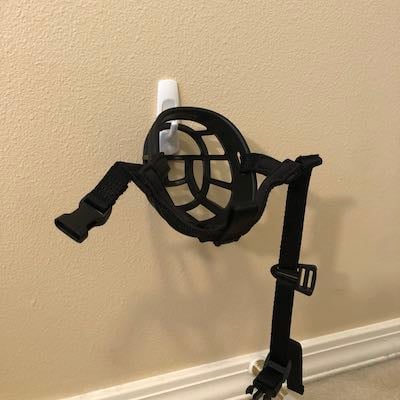
Step Five: Practicing Wearing the Muzzle
Now that you have the process of putting the muzzle on your dog practiced, it's time to help your dog get comfortable wearing it while they move about. This can be tough for many dogs! Just like with dog booties, wearing something on their face can be overwhelming or bothersome. Never leave the muzzle on if you notice your dog shutting down, not moving, pawing at it, or trying to rub it off.
In this video, you'll see Buddy's owner working on connecting the straps of the muzzle and helping him get used to wearing it. In the first portion, you'll notice how Buddy starts to paw at his muzzle, which is something we don't want to see. Buddy started to not want to move with the muzzle on and got frustrated that he couldn't eat treats off the floor while wearing it. In the second half of the video, we shift the process a bit to address this, introducing movement as he wears the muzzle.
I like to keep the dog busy while wearing their muzzle by asking for other tricks or training cues they already know. Do a minute or two of fun training practice and then take the muzzle off. Build up the time they are wearing their muzzle and moving around, focusing on keeping them happy and not thinking about what they are wearing.
If your dog is especially nervous and they need to wear their basket muzzle for longer than they are used to, consider spritzing the muzzle with ThunderEase Calming Pheromone Spray.
If your dog is struggling with moving around while wearing the muzzle, one great option is creating a false muzzle (a muzzle with the front cut out). Do be aware that a false muzzle is not meant to prevent bites — it's meant to aid in the muzzle desensitization process. This can be a perfect choice for dogs who love toy play to pair wearing the muzzle with something they enjoy. Check out this photo and post from the Muzzle Up Project for an example of a false muzzle:
The caption reads, "*Please note, using this muzzle will not prevent a bite. It is to aid in the muzzle training process*
Here is a great example of the "false muzzle". The front of the muzzle is cut off to allow easier/quicker treat delivery, or even fetch/tug/toy play; this can really help with the desensitization process for some dogs. This is a GREAT stepping stone towards your end goal of your dog being able to happily wear their muzzle while out in the world.
Thanks for the photo @muttley__crew !!"
Should You Use a Soft Dog Muzzle?
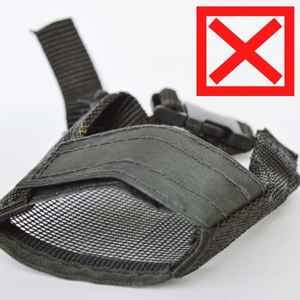
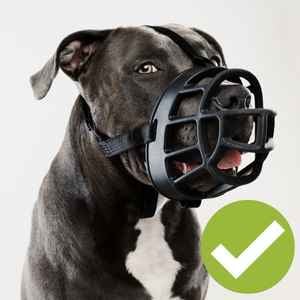
I do not recommend using a soft muzzle (also called an occlusion muzzle) for your dog. These should only be used for very short periods of time at a veterinary office or in emergency situations. These types of muzzles should never be used to stop barking.
Soft muzzles prevent the dog from opening their mouth (hence preventing a bite), but this means your dog cannot pant comfortably to cool themselves, has a harder time drinking water, and the tight fit can increase stress. Opt for a basket muzzle instead.
Emergency Muzzles for Dogs
Knowing how to make a DIY emergency muzzle if a basket muzzle isn't available can come in quite handy. I have used this technique myself when trying to help an injured dog in pain who was trying to bite me when I needed to pick him up to take him to the veterinary clinic. These techniques are especially important for veterinary staff and shelter staff, and volunteers to know, as they may find themselves in need of quick control of a dog exhibiting bite risk.
You can use a long strip of gauze or a dog leash. A long shoelace can work as well. Keeping extra leashes or slip leads handy in your car or bag is always a good idea, just in case you ever need one!
Safety Note: Never use a retractable leash for an emergency muzzle. Do not use this type of emergency muzzle on flat-faced dogs, as it can severely impact their ability to breathe.
How Long Does it Take to Train Your Dog to Wear a Muzzle?
Typically, muzzle training can take between 2 to 4 weeks of consistent daily training practice. However, this may be faster or longer depending on your individual dog.
It's crucial to training success to go at your dog's pace! If we try to force a dog to wear a muzzle too soon in the process, we will create a negative association with seeing it and wearing it. That negative association means that your dog will likely avoid or fight against having the muzzle put on in the future, or get stressed while wearing it, and try to slip out of it. The last thing you want is to create more stress for your dog.
To increase the speed with which your dog acclimates to wearing a muzzle, make sure that it is always paired with high-value reinforcement. Never force your dog to wear the muzzle in an effort to "get them used to it." If your dog is constantly pawing at the muzzle, trying to rub it off on the floor or wall, or shuts down and won't move naturally with it on, that means you need to go back in their muzzle conditioning training.
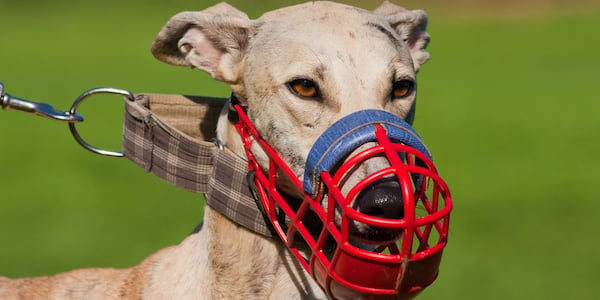 Need professional help as you work on muzzle training your dog? I'm here for you!
Need professional help as you work on muzzle training your dog? I'm here for you!
Schedule a Virtual 1-on-1 session with me to discuss your dog's muzzle training.
How Long Should a Dog Wear a Muzzle?
As long as your dog's basket muzzle is fit properly and they can drink water with it on, a good rule of thumb is that they can wear it for up to 60–90 minutes at a time. Because basket muzzles allow for panting and drinking, you can extend this time longer if needed, but you do want to take into account how comfortable your dog is wearing the muzzle and other environmental stressors.
Monitor your dog continuously while wearing a muzzle to make sure there is no chafing or rubbing on the bridge of their nose under the muzzle or on the sides of the muzzle. You may need to add felt or neoprene padding to certain parts of the muzzle to prevent chafing, especially if your dog has a particular muzzle shape (such as Bull Terriers) or little to no fur protection in those areas.
Clean your dog's muzzle twice weekly with a soap and warm water soak for a deep clean. Allow the muzzle to fully dry before the next use. This prevents the build-up of bacteria, as your dog is certainly going to be getting drool on their muzzle. You can also use pet grooming wipes, like these Furbliss deodorizing wipes, after each use to prevent odor build-up.
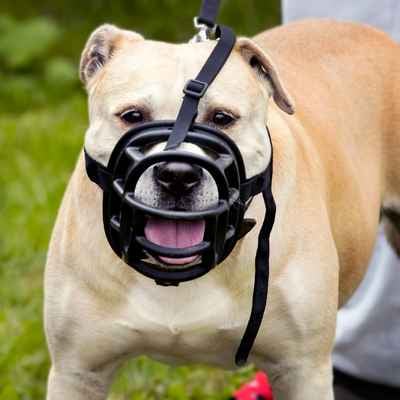 What Dog Muzzle Should You Use for Your Dog?
What Dog Muzzle Should You Use for Your Dog?
There are a lot of dog muzzles to pick from on the market. Your dog's head shape and the reason you are using a muzzle will determine which brand to use. Brachycephalic (flat-faced) breeds need a specially-sized or custom muzzle, as traditional basket muzzles will not fit over their snout or stay in place. Dogs like Miniature Bull Terriers have a particularly unique head shape that can require custom-fit muzzles or special modifications.
The most commonly used dog muzzle is the Baskerville Ultra Muzzle, and I like this one for introducing muzzle training and for low bite-risk cases. There are pros and cons to every brand of muzzle, and finding the right muzzle for your dog can mean trying out two or more brands or sizes.
Check out my top recommendations for dog muzzles here to learn more about fitting a dog muzzle, finding muzzles for flat-faced dogs, custom-made muzzles, and more.



